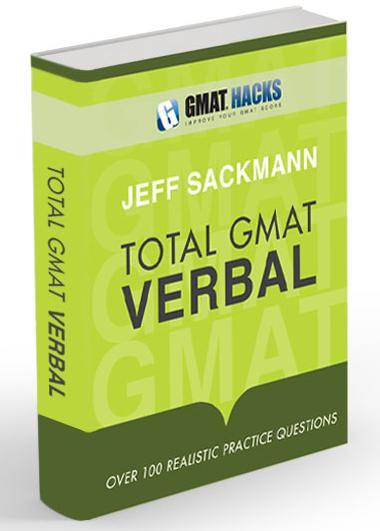
Bookshelf
|
|
Total GMAT Math Jeff's complete Quant guide, on sale now! |
|
|
Total GMAT Verbal Everything you need to ace GMAT Verbal! |
1,800 Practice Math Questions
Buy Jeff's books at Amazon.com

GMAT Official Guide, with IR
OG Math | OG Verbal
OG12 & Quant Rev solutions!
GMAT Question of the Day
Beginner's Guide to the GMAT
GMAT Hacks Affiliate Program

Recent Hacks

Categories
- General Study Tips
- Goals and Planning
- CAT Strategy
- The Mental Game
- GMAT Math Strategy
- GMAT Math Topics
- Mental Math
- Data Sufficiency
- Critical Reasoning
- Reading Comprehension
- Sentence Correction
- Analytical Writing Assessment
- Integrated Reasoning
- IR Explained
- Business School Admissions
- GMAT Prep Resources
- Practice Questions
- Total GMAT Math
- Total GMAT Verbal
- GMAT 111

Take the Drudgery Out of the GMAT Verbal Section
| You should follow me on Twitter. While you're at it, take a moment to subscribe to GMAT Hacks via RSS or Email. |
If you're like me, the hardest thing about the GMAT Verbal section is that it is just plain boring.
The content is uninteresting and unfamiliar, the arguments are flawed, the sentences are ungrammatical (even the right ones aren't very good sometimes), and you've got to focus on every last detail for more than an hour. It's like reading a bad in-flight magazine but with the expectation of a detailed quiz you land. All the tips in the Total GMAT Verbal will improve your score, but they won't make taking the exam any less of a slog.
Unfortunately, there's nothing I can tell you to really solve these problems: Reading Comprehension will always use topics that you don't know much about; Sentence Correction answers will always be objectionable; and Critical Reasoning passages will require you to switch gears every couple of minutes. But I can show you a couple of ways to deal with the drudgery.
Breathe
Yep, it's that simple. I didn't discover this until the last time I took the test, just a few months ago. What makes the GMAT Verbal section so stressful is that you force yourself to change gears from question to question, and there's no logical transition. That's not how you operate in real life, so it isn't how you should operate during the exam, either.
Instead, try this. After you click an answer choice and hit "confirm" to move on, close your eyes, take a breath, count to three, and then–only then–open your eyes and look at the next question. Like I said, it's simple. But if it works for you as well as it works for me, you won't believe the difference.
In case you're worried about using so much time to do something other than answer questions, do the math. Three seconds times forty breaks (one between each question) is two minutes. I guarantee you that you'll save that time by being that much more refreshed when you look at each question.
Turn Your Focus Away From the Screen
I'm a big proponent of doing as much scratchwork as you can–in other words, move the problem off the screen and onto your scratch paper. That isn't really possible on verbal, at least not to the same extent that it is for math. However, there is one way you can get your eyes off the screen for another moment or two.
Each question, after you take a short breather, don't look right back at the screen. Instead, turn your focus to your scratch paper, where you'll write the number of the question, and "A B C D E." That way, if the question turns out to be tricky, and you want to keep track of which answer choices you can eliminate, you can cross them off on your scratch paper.
Will you always use it? No. Will it take you an extra second or two? Yep. Is it worth it? Absolutely.
Effective Transitioning
As I suggested above, you don't rapidly switch from one type of work to another in your daily life: when you finish one task, you take a break, call a friend, or have a bite to eat before moving on to a new project. Obviously you don't have time for anything like that, but you can simulate the experience.
Beware, however: a five-second break is really just a way of tricking your mind into thinking it got a break. By the end of the test, your mind will have caught on–it's not really getting a break, it's just getting a pause. You may find that, to get the same effect, you need to stretch the breaks out a bit longer to get the same effect. If that happens, of course, watch the clock carefully: if you have the time to spare, use it; if not, it's more important to slog your way through the rest of the exam.
About the author: Jeff Sackmann has written many GMAT preparation books, including the popular Total GMAT Math, Total GMAT Verbal, and GMAT 111. He has also created explanations for problems in The Official Guide, as well as 1,800 practice GMAT math questions.
 |
Total GMAT Verbal
The comprehensive guide to the GMAT Verbal section. Recognize, dissect, and master every question type
you'll face on the test. Everything you need, all in one place, including 100+ realistic practice questions. |